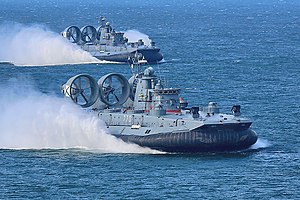Zubr class LCAC

Mordoviya and Evgeniy Kocheshkov
|
|
| Class overview | |
|---|---|
| Builders: | PO More Feodosia Shipbuilding Company, Crimea |
| Operators: | |
| In commission: | 1988-Present |
| Active: | 8 |
| General characteristics | |
| Type: | Air-cushioned landing craft |
| Displacement: |
|
| Length: | 57 m (187 ft) |
| Beam: | 25.6 m (84 ft) |
| Draught: | 1.6 m (5.2 ft) |
| Propulsion: |
|
| Speed: |
|
| Range: | 300 nmi (560 km) at 55 knots |
| Complement: | 31 (4 officers, 27 enlisted) |
| Sensors and processing systems: |
Ekran-1 navigational radar, Lazur radar (Pozitiv radar on MDK-51), R-782 Buran communications system |
| Electronic warfare & decoys: |
Electronic Countermeasures System: Decoys, MS-227 chaff launcher, MP-411 ESM radar system; intercept |
| Armament: |
|
The Zubr-class (Project 1232.2, NATO reporting name "Pomornik") is a class of air-cushioned landing craft (LCAC). This class of military hovercraft is, as of 2012, the world’s largest, with a standard full load displacement of 555 tons. The hovercraft is designed to sealift amphibious assault units (such as marines and tanks) from equipped/non-equipped vessels to non-equipped shores, as well as transport and plant naval mines.
There are currently seven Zubr-class hovercraft in active service worldwide with several pending delivery. There are two vessels in service with the Russian Navy and four with the Hellenic Navy. In 2009, China placed an order for four vessels from Ukraine as part of a deal worth 315 million USD. Two updated versions of the vessels will be built at Crimea's Feodosia Shipbuilding Company followed by two advanced models of the surface warship.
The purchase of HS Cephalonia (L 180) for the Hellenic Navy marked the first time a Soviet-designed naval craft had been built for a NATO member.
High strength and buoyancy is provided by a rectangular pontoon, the main load-carrying part of the ship's hull. The superstructure built on the pontoon is divided into three compartments with two longitudinal bulkheads: combat material compartment in the midsection fitted with tank ramps, and outboard sections housing main and auxiliary propulsion units, troop compartments, living quarters, and NBC protection systems. To improve working conditions in the battle stations, troop compartments and living quarters are fitted with air-conditioning and heating-systems, sound/heat-insulating coatings, and structures made of vibration damping materials. The ship provides normal conditions for the crew to make meals and rest.
Personnel are protected against the effects of weapons of mass destruction by airtight sealing of combat stations, crew and troop compartments, augmented with individual gas masks and protection suits. The ship is also protected from magnetic influence mines with an active system to compensate for the magnetic fields generated by the ship and transported materials. The central command post and MS-227 device compartments are strengthened with alloy armor.
...
Wikipedia
